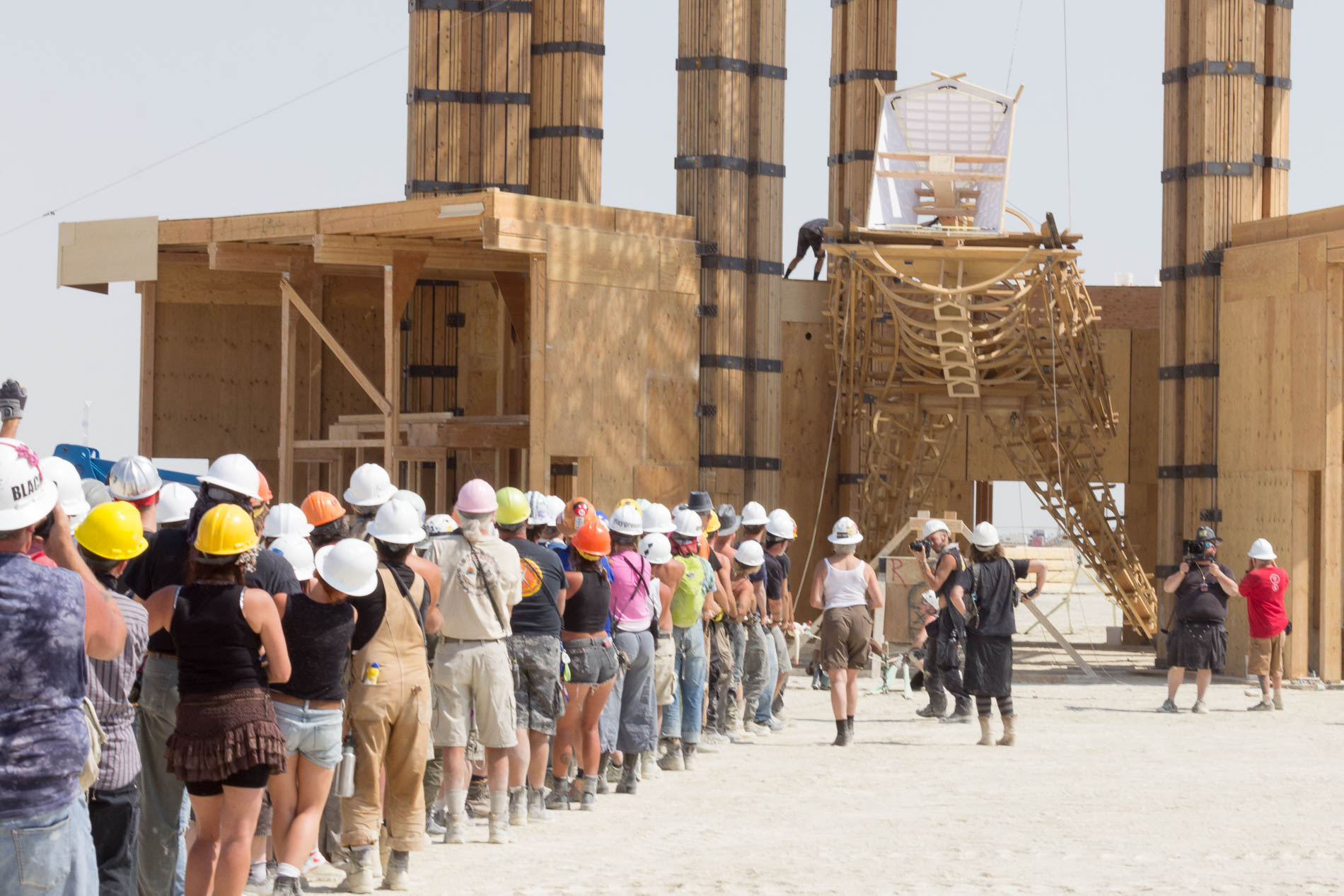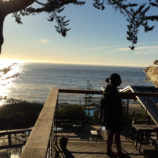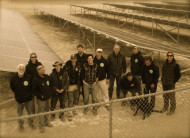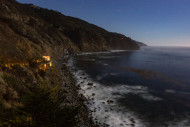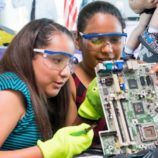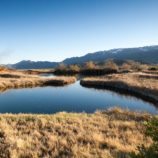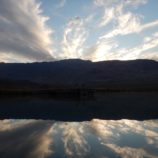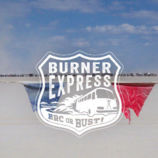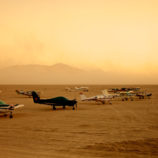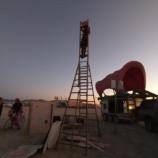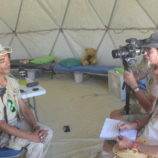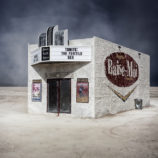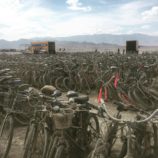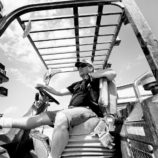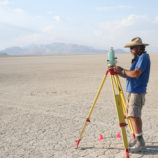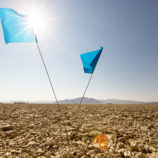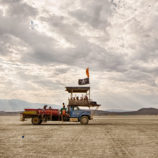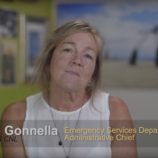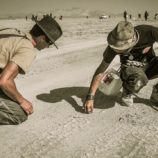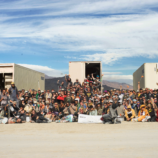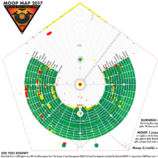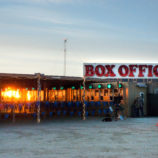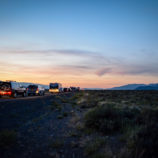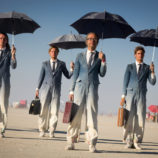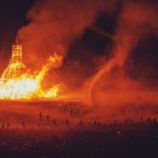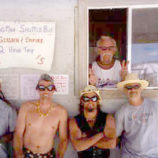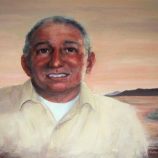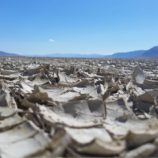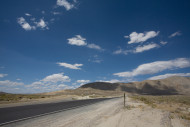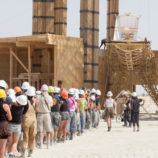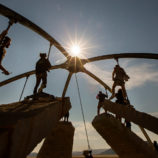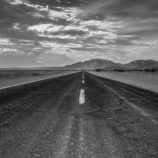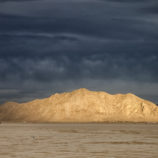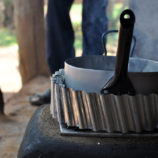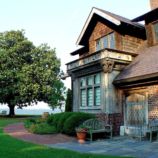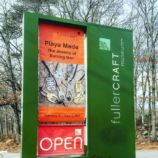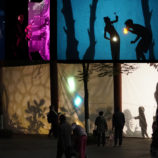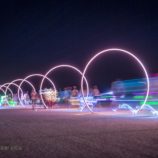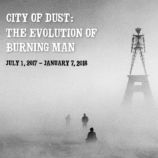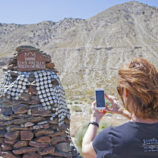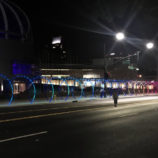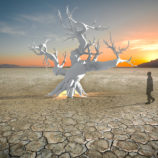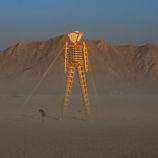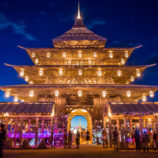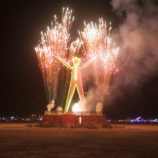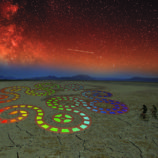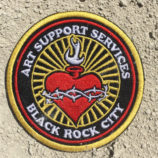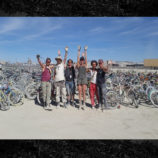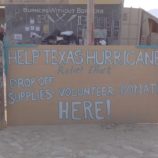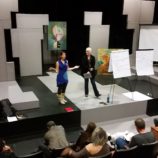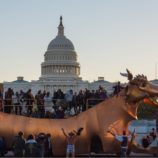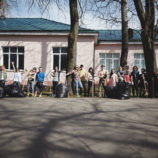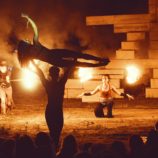The AfterBurn is our annual look back at the past year in Burning Man history — its ups, its downs, and its get-back-up-agains. It provides an overview of the Burning Man organization’s operations, our objectives and the obstacles we encounter. Our hope is that this report will help provide a context for understanding the organization and people behind the event in Black Rock City.
The Burning Man organization, also known as Burning Man Project, includes a full-time staff, a larger group of part-time seasonal staff, and thousands of volunteers as well as participants who take responsibility for making Burning Man happen in the Black Rock Desert and around the world. The AfterBurn Report explains what our various departments do, why they do it, what changes occur year to year, our successes and failures, and our vision for the future.
Browse past years’ AfterBurns here.
We also publish an Annual Report each year about our overall vision, impact, and health as a nonprofit.
Burning Man 2017: Radical Ritual
 Theme Series:
Theme Series:
Radical Ritual
In 2017, Burning Man Project turned from expanding our scope to deepening our work. We held our largest-ever Global Leadership Conference, built out the content of our conference for Theme Camp organizers, and held the first-ever Philosophical Center Symposium. We awarded our first Land Fellowship to study the ecosystems of Fly Ranch, and we expanded our Fiscal Sponsorship program to virtually any kind project aligned with our mission. The Art Team launched a new multi-year grant process for building the Temple in Black Rock City. We also began the 10-year Environmental Impact Statement with the Bureau of Land Management, as our partners at Black Rock Solar pivoted to become Black Rock Labs, an accelerator for clean-tech projects born in the Burning Man community.
The “Radical Ritual” theme turned out to be far more subtle — and powerful — than people expected. Unspecified fears about what would happen with the Man housed inside a structure turned out to be unfounded. Indeed, it was arguably the most significant Man build in many years. The roof over the Man’s head was the heaviest piece ever lifted in Black Rock City, a sign of the incredible level of engineering and coordination we’ve reached out there. Yet the Man was standing on the ground, and the crew raised it with the classic rope lift for the first time since 2000, a moving show of the centrality of tradition in our culture, no matter how snarkily and irreverently we treat it.
The 2017 event was indelibly affected by the death of Aaron Joel Mitchell, a first-time Burning Man participant who ran into the fire during the Man Burn, evading the perimeter personnel who tried to stop him. The incident shook our community. The outpouring of compassion for Joel and his friends and family, and gratitude for the Black Rock City Emergency Services Department and emergency response personnel who tried to save him, immediately initiated a process of healing.
The Temple Burn, a perfect ritual for representing that healing, was carried out the following night. It took compromise and negotiations with government officials to even allow the burn to go forward, and the compromise resulted in a heroic effort by BRC personnel to build a perimeter fence in a matter of hours. The Fire Art Safety Team’s resounding call for 300 perimeter volunteers in the wake of the tragedy was answered by more than 700 people. The gorgeously minimalist Temple by Marisha Farnsworth, Steve Brummond, Mark Sinclair and crew could not have been a more poignant symbol of loss and renewal.
As always, though, there wasn’t much time to rest. During the Burn, powerful hurricanes struck land and upended the lives of countless people, creating eerie echoes in BRC of Hurricane Katrina’s landfall in 2005, which led to the founding of Burners Without Borders. Even before the end of the event, BWB volunteers had sprung into action to provide relief and help rebuild communities in the hurricane zones. Our work is never over.
(Photo by Shalaco)
Table of Contents
For complete descriptions of the various Black Rock City teams, visit the Teams page.
Burning Man Project Staff and Operations
Stuart Mangrum from Education writes: We made substantial progress this year on refining the Burning Man leadership model and building out a comprehensive learning curriculum to support it. We developed and iterated staff trainings in emotional intelligence, interpersonal communication, and other critical leadership skills, and field-tested them at educational events including an expanded Theme Camp organizer conference, our staff retreat at Esalen, and our largest-ever Global Leadership Conference.
We also held our first Education Symposium in San Francisco, a quick reimagining as an urban conference after the Mayacamas Ranch, a beloved Burning Man retreat venue, was destroyed in the Wine Country wildfires. We began a two-year process of reorienting the volunteer Documentation Team to better support year-round events, and expanding its on-playa charter to include more direct support to departmental training managers, with assignments to capture photos and videos for 2018 training development for ACE, ESD, and other teams. We invested in the tools and processes to support better delivery of web-based training, configuring and testing a learning management system (LMS) and the associated authoring tools to create trackable online training in a distributed learning environment.
Josh Lease writes: We continued the growth and expansion of the Fellows Program in 2017. Lisa “Scirpus” Schile was awarded our first Land Fellowship for her work on wetlands and was granted access to Fly Ranch to conduct independent research on the ecology of the land. Tony “Coyote” Perez-Banuet was awarded a fellowship to support his effort to write a book on Burning Man entitled Coyote Nose: The Tales of the Early Desert Carnies of Burning Man. We granted over $40,000 to support their work.
Our Fiscal Sponsorship program has grown from a program that only supported Black Rock City Honoraria recipients to empower mission-aligned projects to raise tax-deductible donations almost anywhere in the world. Sixteen Fiscal Sponsorship projects around the world raised over $73,000 in 2017, 12 of them in Black Rock City as well as four Civic Engagement and Regional projects.
Kyle Swarthout from Finance writes: Finance quietly performed and executed an extraordinary amount of activity day-in day-out from January 1, 2017 through the end of the year. We completed an audit with an extremely good report card noting no material weaknesses in internal control.
Lisa Nash from Nevada Properties writes: The new tower is up and functioning in Gerlach. It took three years to get it through the county, permitting, etc. and is finally done and approved. We remodeled the Gerlach Office rear room, increasing space from 11 spaces to 20 spaces. NVP, HEaT transportation and DPW worked together to greatly improve the coordination of transportation and storage of the physical assets needed for the playa. We stored, moved and re-stored more items than ever before and did it more efficiently and with better cross-department coordination and cooperation.
The best story from 2017 was the fire that happened behind the Gerlach Office in July. We had a transformer blow directly behind the office one afternoon while the office was in full swing and the trailer park was fully occupied. The brush below the transformer caught fire, and it quickly spread towards a shed on the Gerlach Office property. Our staff responded promptly with our newly filled and certified fire extinguishers, helping to control the fire until the fire department arrived on scene. The staff helped manage onlookers, coordinate with the Gerlach Volunteer Fire Department, plan for a possibly prolonged power outage for the whole community and assist with monitoring the fire site for flare ups as the day progressed. It was quite an exciting afternoon and showed how well all our teams come together.
Marci Bennett from People & Operations writes: We never thought we could find HR volunteers, but we cast a line out to the world, got an incredible response, and ended up having a team of 11 volunteers work with us on playa this year. We actually underestimated the level of involvement volunteers would want on playa and didn’t end up having enough work for them to do. We heard them loud and clear in our post-event feedback: get them more involved! We also re-launched our Behavioral Standards process and documentation so staff can be reminded of our baseline for what is expected of them when representing Burning Man. We expanded our feedback training, offering it at BMHQ in January and February, at the GLC in March, at the DPW Manager’s Weekend in April, and at the staff retreat in October.
From the Journal:
Fly Ranch
Matt Sundquist writes: This year, we took people from Black Rock City on walks at Fly. Each walk was a different exploration of the property. We took some wrong turns, walked into a swampy area, and got way too hot. But this process led us to the route and approach that we like and are going to use for our public walks. There’s probably a metaphor in there about teamwork, making mistakes and improvements, and the journey being as important as the destination. We’ve started to engage people. We had three talks in BRC, a talk at the GLC, led six weekends of open walks, and launched our website with 40 pages of content.
From the Journal:
Government Affairs
Marnee Benson writes: Unusually high winter rain and snow led to flood conditions in the Black Rock Desert in the spring of 2017. News reports showed people swimming and kayaking on the playa where Burning Man is held. Behind the scenes, we worked diligently with a team of hydrologists and geomorphologists to measure and track playa conditions, and we were evaluating alternative sites for the event. We worked with numerous state, federal, tribal, and county agencies to understand our options and make certain we were prepared. In the end, the playa dried out, and we had outstanding playa conditions on site.
2017 marked the official launch of Burning Man’s next environmental impact analysis under the National Environmental Policy Act. We are applying for a 10-year permit with the Bureau of Land Management and submitted a proposed action to hold the event in the same location of the Black Rock Desert. With BLM, we are exploring potential changes including a population increase and expanded public transportation to and from the event. Resource experts conducted studies on site before, during, and after Burning Man, and the first public outreach meetings were held in Gerlach, Reno, and Lovelock.
From the Journal:
Technology
Heather “CameraGirl” Gallagher writes: We created new systems for submission and committee review of Temple Grant Program LOI and Applications. We opened BRC Honoraria LOI and Grant application system in the fall, three months earlier than in previous years, to enable artists to have longer lead time to work on projects. We migrated our entire image collection into a new robust digital asset management system and built a new image gallery for burningman.org, including a portal for participants to upload images for moderation. We re-architected the Placement database to enable historical linking between camps and greater scalability and efficiency of the team. We streamlined the thank-you card process and improved data quality by leveraging participant-maintained data in Burner Profiles. We incorporated Burner Profile Global Unique Identifier (BPGUID) throughout Burning Man and vendor systems, wherever possible, to improve data reconciliation and quality. We redesigned donation experiences for Fly Ranch and burningman.org. We designed the first printed Annual Report. We reduced technical debt across the department. A planned move into a new vendor’s logistics request system was delayed after prototype efforts revealed the software was not ready to meet our needs. In Black Rock City, we faced a perfect storm of challenges: extremely hot weather, transformer failure, frequency interference, and multiple upstream ISP routing issues, negatively affecting the quality and timing of the BRC Network for operations and participant groups. We are focusing multiple efforts on supporting our network for 2018.
Black Rock City Event Operations
It was a hot one in BRC this year. The lack of storms brought more people to the event and amped up their behavior, but the intense heat increased the number of incidents of all kinds. The primary community-facing push in 2017 was Project Citizenship, an invitation to all participants and staff to “do it right.” The project’s various implementations touched all ticket buyers, all mass transit users, and other specific niches within the Burning Man community, such as artists and mutant vehicle owners. We’re still analyzing which parts of this program had the most impact. The death incident on Burn Night was tragic. However, the response on the ground from all BRC safety departments was professional. All cooperating entities, external and internal, worked well together, and the response coordination went just about as well as it possibly could have. BRC first responders and others affected by the incident have been offered a variety of support options through the various communication and outreach channels.
Burner Express
Audrey Whaling from Burner Express writes: For Burner Express Air, the biggest success of this year was changing the relationship BxA had with BRC and the Airport. It went from working with purely an outside vendor scenario to an integral part of the Airport team and process. We were able to develop solid communication with participants, with collaboration across many different volunteer teams that before this year barely talked to each other. We had more cross departmental communication that even consisted of a Group Hug at the beginning of the event. BxA and the Airport were also able to support each other in so many ways! Even with two presidential visits to Reno and fires all over Nevada impacting the airspace with flight restrictions, BxA was still able to fly more more than 5,800 participants into and out of BRC. The program was also able to offer several more benefits to participants flying into Burning Man including a more regularly scheduled shuttle service to and from the Airport, pre purchased water sales, and more acculturation, education and engagement for participants coming into BRC. We need to communicate better with participants about flight timing and delays.
The Burner Express Bus managed to navigate a political protest in San Francisco causing a last-minute location change, but everybody got to BRC. On Wednesday 8/30, HWY 447 was going to close due to wildfires getting dangerously close to the road at 6 pm. The last buses made it through prior to the closing, but that meant the drivers were “trapped” on playa until the morning. One of the drivers had driven for BxB for the past three years, and though he always requested to drive, he never got to stay for Burning Man. He came prepared with a bike and a hammock and was finally able to experience the city for all its wonder. Another driver got to experience the different art pieces running around with the BxB manager, and all he could say was, “Crazy.;“ It was the best outcome for a tough situation. In the past few years, the BxB depot — which sees over 12,000 travelers — has had challenges with MOOP. This year the team really stepped up its game and line-swept the heck out of the depot. The team was enthusiastic and developed their own parody MOOP-related tunes to keep them going.
From the Journal:
Communications
Dominique Debucquoy-Dodley writes: In an effort to combat some disturbing participant behavior on playa, the Communications team took the lead on a cross-departmental push, dubbed Project Citizenship. Things kicked off at the Global Leadership Conference, with Jim Graham hosting a breakout session announcing Project Citizenship to members of our regional community. We then began working on how we could best reach our community focusing on four key messages. 1) “Be Prepared,” 2) “Contribute,” 3) “Leave No Trace,” and 4) “Be Kind.” Our flagship campaign for year one was an email push titled “From the Desk of Charlie Dolman,” with a total of six emails focusing on our key messages sent to both Pre/Main Sale ticket buyers as well as DGS ticket buyers. Rusty Blazenhoff was brought on board to craft the voice of these emails, and the Communications team worked collaboratively to tweak the messaging.
We also produced three “acculturation” videos. The first focused on Leaving No Trace, MOOP, and Playa Restoration and featured DA. The second was about Gate/Perimeter/Exodus procedures and how participants can take care of themselves during Exodus, and featured Ira Wing. The third video focused on ESD and how participants can best prepare for their experience on the playa, and featured Kate Gonnella.
We created acculturation packets for the Burner Express program, both Air and Bus. Rusty was also the lead on these pieces of collateral. Project Citizenship messaging was incorporated in many of our Communications channels and collateral, from ticketing pages, to placement newsletters, to the Survival Guide.
We asked our staff teams to help us by taking action in their own camps during the 2017 event in Black Rock City. The first year of this effort received lots of positive feedback, and was a great starting point for the efforts that are now underway. Comms team hired two new team members (a Communications Manager and Communications Administrative Associate), taking our office staff team to five. We received 90 requests for long-form interviews or speaking engagements in 2017, and we participated in 48. We published 250 posts on the Burning Man Journal.
From the Journal:
Burning Man Information Radio (BMIR)
Joshua “Kanizzle” Cunningham writes: For the 63rd year in a row we were the #1 rated station in Black Rock City. The BLM still loves us. RonJon has not set anything on fire at the station yet. I’ll call that a win. In general, BMIR was a super smooth ride this year, as it has been for the past several years, without any major hiccups. Our mixing board broke on day one, and we scrambled together a makeshift one utilizing two tiny mixing boards. Our engineers are amazing! We started a new rideshare program for the end of the week when we become the BRC Municipal bus stop that proved to be more helpful than what we’ve done in the past, but it definitely needs some tweaking.
From the Journal:
Census
DV8 writes: 2016 was the first year BRC Census had a work support camp, but 2017 was the first year that we had an awesome, interactive, thematic work support camp! We had several Census volunteers camped out just a few blocks from Census Lab, providing nerdy goodness to anyone who stopped by. Our wonderful Counter Culture campers hosted a “Correlation and Cocktails” get-together after our Preliminary Data Release at Census Lab, and we had a fantastic time socializing with our volunteers and fellow nerds on-playa. Mu, one of the Census Volunteer Coordinators, has spent an amazing amount of time improving the technology used by Census leadership to keep our 150+ volunteers organized and prepared for the playa. This year was the smoothest year yet for sending welcome letters, tracking shift sign-ups, monitoring work arrival needs, and all the other things that used to take up a ton of our time. We’e working on plans to improve the Burn/life balance for key volunteers on playa. We don’t want to lose valuable volunteers to feelings of over-work or under-appreciation, and we’re thinking about ways to stave that off.
From the Journal:
Media Mecca
Dominique Debucquoy-Dodley writes: In an effort to push for quality over quantity, we focused our media project proposal review process on taking down the overall number of BRC media projects by 1/3. This allowed our Media Mecca volunteers to provide guidance on higher quality work, and several fantastic pieces came out of the 2017 event. We approved 187 out of 285 applications, and we accepted 35 walk-in projects at Media Mecca.
From the Journal:
Community Bikes
In 2017, 3,754 bikes were abandoned by participants with no regard for the principles of being a Black Rock City citizen. People either dropped the bikes carelessly, or they left them unlocked to be stolen and abandoned. This created tons of work for other Burners just like them, who spent days cleaning them up and getting them hauled off playa. We shared this story of how they pulled it off so Burners can realize the impact of their actions on their fellow participants, plan accordingly, and pack out everything they bring — including bikes.
From the Journal:
Community Services
Dee Zaster from BRC Airport writes: 88NV Airport had an exciting year, thanks to nasty dust, frequent medevacs, and a tremendous crew who weathered it all in stride! The all new Airport Council had a successful first year in operation as we worked to welcome more Burners than ever through Airport Gate. We got a shiny new radio communications tower and a fourth radio frequency, giving pilots more time to communicate on approach and fly safer. We were able to have a great year because of the tremendous support and collaboration of departments outside Airport. We are not going to have dumpsters at the airport ever, ever again. Despite locking and monitoring them, we found them to be an attractive nuisance more than a waste stream solution. To this end we are adding an entire waste, resto, and grounds maintenance team to the airport logistics crew. The new team’s focus will be maintaining the airport MOOP patrol during and after the event, as well as handling the ever-increasing job of packing away infrastructure for the next year.
Marcia Crosby from Center Camp Café and Arctica writes: Arctica expanded their pre-event service to artists and theme camps by opening both downtown Arctica (in Center Camp) and Ice 9 (9 & G) before the Gate opened, which helped alleviate the long ice lines we saw pre-event in 2016. The Cafe’s Coffee Shop and all three Arctica locations will be trying out iPad-based cash registers with a touch screen instead of old-school cash registers. The Cafe’s Decor Team will create at least one of its annual projects out of waste-stream/recycled materials (cardboard and plastic bottles) with the goal of demonstrating to our community that these free materials can be reinvented into fun and colorful decor, as well as allowing us to compost the cardboard and recycle the plastic at the end of the event, effectively modeling an LNT life-cycle for decor projects.
Dapper from the Department of Mutant Vehicles (DMV) writes: The DMV currently processes mutant vehicles almost entirely electronically by using wirelessly networked iPads that communicate with a central database housed at the NOC. It has been years since a paper-based system was used, but every year we “go through the motions” of having paper backups of everything in case the system goes down. In 2017, the system went down. Hard. The NOC was unable to restore our access to the database for several hours, a period of time during which we would normally process anywhere from 50 to 100 mutant vehicles. When it became evident that database access was not going to be restored in short order, our volunteers transitioned to the backup paperwork, and despite being a process which many of our volunteers had never seen, everything proceeded smoothly. While we weren’t able to process vehicles as quickly as we would have electronically, it was extremely satisfying to see a contingency plan operate successfully.
Karina O’Connor from Earth Guardians writes: Our new Kids LNT Juice and Snow Cone Bar was a great success! The late afternoon kid-run bar shared space with our alternative energy garden and provided snow cones and juice to kids of all ages armed with facts about Leave No Trace and Black Rock NCA. Per BLM request, we greatly expanded the number of LNT outreach shifts to include both more shifts during the event, but more shifts before the event officially opened. We added another volunteer coordinator, trained many new volunteers, and now have a second volunteer camp! We had over 60 Black Rock Desert and earth-centered events which included bike tours, lectures, moderated panel discussions, DIY workshops, music and dance events. All of our events were well attended and • This year we re-invigorated our MOOP train with champagne! The champagne MOOP train attracted many participants to deMoop areas of Black Rock City. In past years the focus on the MOOP train was the trash fence, however since the fence was so clean this year, the train made its way to many of the larger art pieces around the city to deMOOP.
Topless Deb from Greeters writes: We upgraded the Greeter Beacons in 2017. Lag Screws versus rebar… no more pounding! The Greeter recycling program at Greeters Station continues to be successful. We had 21 theme camps Greet with us this year. There are 500 or so active Greeters on playa. We have 24 outstanding leads outside of the amazing leads that come with theme camps. The 28-member collate team put together more than 80,000 packets of printed material in five days!
Snotto from Lamplighters writes: Newbies made up more than 50% of our team this year, and we worked really hard doing newbie acculturation activities to make them feel part of the team. We had a newbie ceremony after they lit the city the first time. We had a newbie/veteran scavenger hunt. The veterans worked on welcoming all the newbies, and the newbies excelled as first-year Lamplighters. The night of a big dust storm, we halted Lamplighting because we weren’t going to send volunteers out in lightning with giant metal rods hanging lanterns. We lost most of the outside-the-village volunteers, but we rallied our camp with all hands on deck and still lit the city later that evening when the storm rolled through.
Trippi Longstocking from Placement writes: We placed 1,395 camps with 18 volunteers in 2017. The Placement Team had a transition in leadership this year: Answergirl — who started as a volunteer and ended up as Placement Manager for five years — decided to retire. Trippi Longstocking was hired to fill the role in March 2017. They had a successful two and a half month transition together. (In Burning Man parlance, this is known as “sage quitting”). Trippi’s first day of work coincided with our March Theme Camp Symposium. We had 200 in-person attendees, and 75 remote attendees representing 175 camps. We hosted two camp panels and an afternoon of breakout sessions. We brought the Placement Newsletter into the 21st century with rich formatting and images. We can now see statistics, and this year we had average of 46% open rate and 11% click rate.
In April and May, Placement collaborated with Playa Restoration to call and email camp leadership of top 37 worst MOOP score camps from 2016 (ranked on total number of non-green square feet as well as camps who were >75% red). We educated them on LNT, talked about the specific issues in their camp, and received concrete plans for how they would improve in 2017. The results comparing those camps improvement from 2016 to 2017 are fantastic: In 2016, our worst MOOP camps were on average 30% red, 25% yellow and 45% green. In 2017 these same camps were on average 7% red, 8% yellow, and 85% green! Only 3 of the 37 camps substantially worsened in 2017. 92% improved. Placement Team continued working with camps who need additional support and cultural education to be successfully interactive, public, inviting camps in Black Rock City.
From the Journal:
Terry Schoop from Playa Info writes: The council recruited a new member for better workload distribution and succession planning. We will be adding more work shifts at the end of the week when the need is greater. 2017 was the first year that phones were our biggest lost and found category, exceeding IDs. It was only in 2015 we had enough lost phones to create this category. It’s more important than ever that folks label their belongings with their name and contact information. When they do, we achieve a 82% return rate!
Blue from Recycle Camp writes: Through a generous gift, Recycle Camp participated in the IDEATE/Black Rock Labs carbon offset program. Every camp member, 50 including an unborn child in her mom’s belly, had their Burn footprint offset. Recycle Camp offset a total of 70,000 pounds of carbon. We have worked to expand our drop-in volunteering program, encouraging more people to volunteer with us during the day. Our appreciation parties draw huge crowds. For the second year in a row, we filled three 30-yard dumpsters with crushed aluminum cans. From the rebates received, we were able to donate $2,000 to The Gerlach School again in 2017.
Volunteer Resource Team writes: We successfully went from a single location in the 6:00 portal to three locations at 3, 6 & 9. In doing so, we more than doubled the size of our volunteer crew, serving more potential volunteers than ever before. We learned so many things that we still need to implement in order to have the three-way run gracefully: update our communication between locations to better disseminate new information such as new volunteer opportunities to all locations; implement new training; create more specific tasks and create leads for those tasks; create a fluffing sub team for all three locations and Playa Info.
Marcia Crosby from Temple Guardians writes: Temple Guardian volunteers asked for a near-to-Temple location to officially check in with their shift lead before their shift, and check out post-shift. After the 2016 event, the former Gerlach-Empire Bus Depot building was retired, and in the Burner spirit of Radical Re-usability (a contender for the 11th Principle?) that small building was repaired and re-established in 2017 as the Temple Guardians Outpost. This Outpost served as a place for volunteers to meet their peers before their shift and then proceed to the Temple as a group while getting themselves ready emotionally to serve as Guardians, and for exiting volunteers to debrief with their leader and peers about the shift just completed.
Department of Public Works
ChAos from the Department of Public Works (DPW) writes: 2017 brought new improvements to the design and construction of the Man. We returned to the aesthetic known as the “classic man” and adapted the structure to include the four chakras along the torso. A great deal of craftsmanship went into building a man that would allow for ground-level viewing, and innovative changes were made to improve the burn. For the first time since 2000, the Man was once again raised by people using ropes and pulleys. The spectacle took us back to a previous time and simultaneously set the tone for the theme, Radical Ritual. On Friday night of the event, a public waxing event was held to prepare the burlap for the Man in preparation for the burn.
DPW saw a wave of new and enthusiastic members joining the team at all levels. Despite many seasoned staff moving on to other life pursuits, the DPW successfully managed the event while adapting to change in more than 20 of its 60 leadership roles.
Power monitoring equipment was conceived and implemented on several infrastructure generators allowing for the real-time display of power consumption. Over time, this new project will allow for more efficient sizing of power grids and improved selection of power distribution equipment, lowering costs and improving working conditions for staff. Light pollution has been growing in Black Rock City in recent years. Diesel powered light towers are a vital component of event infrastructure but cause light to spill out into the night sky while burning fossil fuel and emitting carbon. In 2017, new lighting solutions were implemented in many locations where grid power was already in place, allowing for the reduction of six diesel powered light units. We will continue to improve upon this effort in 2018 and hope to decrease usage by an additional 4–6 units.
Increasing pressure on the event build timeline has resulted in a compressed workload that peaks at the onset of the season. We have always been able to complete the 9.2 mile fence in one day, but in 2017 the process was hindered by the distraction of other efforts taking place simultaneously. Those working on the fence felt the day dragged out too long and DPW morale was negatively affected. We will reinvent Fence Day in 2018, reinvigorating a time honored tradition and bringing our crews back together for the department wide event.
From the Journal:
Emergency Services
Kate Gonnella from the Emergency Services Department (ESD) writes: We have always expected the unexpected in BRC, and provided ample proof of that. However, it was also a clear demonstration that we can all work together and that the opportunities to work and train together pay great dividends. Of note in 2017 were several life-and-limb-threatening situations with exemplary responses from ESD and Rampart. ESD Dispatch received 1,408 calls for service in 2017; there were four days in which there were over 170 calls for service! Average call to arrive on scene time: 9 minutes. ESD treated 4,614 participants; Rampart treated 1,660. Approximately 80% of the illnesses and injuries were minor a treatable with a personal first aid kit. A total of 52 people were transported off site, an increase of 53% over 2016. Crisis Intervention Team responded to a total of 92 calls for service and reassessments, an increase of 24% over the 70 calls in 2016. ESD Fire purchased a propane emergency response kit in 2016 in order to aide in the assessment, leak control and evacuation of propane vessels. This kit was deployed three times during the 2017 event.
From the Journal:
Gate, Perimeter & Exodus
Athibat writes: The best story of this year is that GP&E pulled together as a team for every single challenge that experienced, and there were many: a rain event that shut down BRC, wildfires that shutdown Hwy 447, unexpected technology outages, extreme sustained daily heat, changes in traffic patterns that impacted wait times, surprise road repairs and closures of Hwy 34 during Exodus. There were other internal changes and challenges to overcome as well. Through it all the team faced it with tenacity, gumption, and teamwork. This year, we had our first piece of art created by GP&E staff at the front Gate. It was a wonderful skull created by the incredible Gate Transportation team. Exodus tried a new operation this year. The vendors leaving through the Point 1 Gate were pulsed out in groups instead of freely flowing. This allowed the staff at Gate Road entrance to stop the main flow of traffic significantly fewer times than ever before. Thanks to this, wait times never went above three hours to leave BRC, despite road closures.
From the Journal:
Playa Restoration
Congratulations, Citizens of Black Rock! The dangerous trend line of increasing MOOP year over year was dramatically reversed in 2017, thanks to more education and messaging prior to and at the event, and surely thanks to better acculturation and participation of Burners Like You™. Not only did 2017 have one of the cleanest and greenest MOOP Maps we’ve ever had, the Playa Resto sweep was also accomplished in record time, which shows how little MOOP there was out there to pick up.
From the Journal:
Rangers
Safety Phil writes: The incident during the Man Burn was simultaneously a heart-rending tragedy as well as a inspirational example of how the Rangers and other Burning Man departments were able to come together when it mattered most. Aaron Joel Mitchell’s death had a tremendous impact on the Rangers, especially those who served on the Man Burn perimeter or were involved in the aftermath. After the fatality, physically and emotionally exhausted Rangers staffed an extended perimeter well into the next day.
The next evening was the Temple Burn, which almost didn’t happen, but we came together as a community and made it happen. The Rangers led the largest Burn perimeter in the history of the event. And it wasn’t just Rangers; every other department, alongside many unaffiliated participants, came forward to offer volunteers to staff the perimeter. The crowd was exceptional and respectful, having absorbed the terrible news from the previous night. This combined outpouring of cooperation between Rangers, Burning Man departments, and participants made the Temple Burn truly remarkable.
We continued to build on the successes of our Command Training and Troubleshooter programs to increase the number of highly trained, experienced Rangers in the field, and we fielded a revised Incident Management System for tracking and capturing details of incidents involving Rangers. There were 795 Rangers on playa working more than 32,000 total hours in more than 4,600 shifts. At 37 Ranger trainings across the U.S. and Canada, we trained more than 1,500 people in 2017.
Ticketing
Things in Ticketing-land went smoothly in 2017, but that doesn’t mean we weren’t working hard to make things better. After five years at basically the same price point — while costs increased year after year and population remained the same — we had to increase the Main Sale ticket price from $390 to $425, but it didn’t seem to have a dramatic impact on the community, and of course our Low Income Ticket Program remained an option. We also took action to better educate the public about ticket scalpers and their strategies, and what our community does to prevent them from hurting our event and its culture.
From the Journal:
More Event Ops stories from the Journal:
Arts and Civic Engagement
2017 kicked off a series of exciting partnerships with museums, governments and other institutions, including the Hermitage Museum in Norfolk, VA, the City of San Jose, BRC’s neighbors in Washoe County, NV and the National Endowment for the Arts. We also laid the groundwork for more big collaborations to come in 2018, most notably the “No Spectators: The Art of Burning Man” exhibition at the Renwick Gallery of the Smithsonian American Art Museum.
From the Journal:
Art in Black Rock City
Katie Hazard writes: ARTerians (the main ARTery volunteer team): For the first time in team memory, we opened the membership up to new folks. We instituted a process whereby previous volunteers essentially had to re-apply via an Expression of Interest form. And we successfully vetted and recruited 40% new volunteers! We also started an Appreciation Team, and created a new ARTerian logo. There was a successful leadership shift from Ben Stoelting to Gloria Beck as the head of Art Support Services (ASS). Both Ben and Gloria worked in 2017 to ensure a smooth transition. ASS also increased their team size from 40 to 60, and strengthened their Squad Leader system. The Fire Art Safety Team (FAST) recruited their first official Volunteer Coordinator, and Doxie (head of Open Fire) strengthened her team. We started a great system in 2016 whereby every registered artist was assigned an Art Project Manager on our staff as their liaison. We built out the team by adding three new Project Managers in 2017, so we now have a total of 10 staff in that role.
2017 was our second year of having a joined Everywhere/ARTery pavilion, as a physical representation of our coming together via the Art and Civic Engagement (ACE) department. This year we were happy to partner with the DPW Special Projects team who built the structure on playa. We also started to focus more on team collaboration and had an All Teams celebratory toast together. Programming in the space improved, particularly by our adding the Art Speaks artist talks which packed the house.
We launched the new Temple Grant Program in 2017 (for the 2018 Temple). We identified a need, launched the program, and awarded the Temple Grant in December 2017, earlier than it had ever been. We’ve had continued success with LOI process in Honoraria program, receiving 507 LOIs in 2017 for the 2018 event. We launched a new event called the Grants Roadshow. We hosted one event in 2017 and plan to offer 3 to 5 more in 2018. This first event was held in San Jose, to complement the Playa to Paseo project there.
We had 317 total art installations on playa, including 71 Honoraria, 30 Shrines around the Man Pavilion and in the Plazas, and 216 self-funded pieces. We provided artists $1.2 million in funding. We nearly doubled last year’s number of international projects: from 27 in 2016 to 54 in 2017. We received 554 LOI applications for the Honoraria Program and 12 proposals for the Temple.
From the Journal:
Burners Without Borders
Christopher Breedlove from Burners Without Borders writes: We never expected the fall season to be like it was this year. With Hurricane Harvey starting just before the Burning Man event was about to open, many people were saying that it felt like 2005 (when Katrina struck and Burners responded, which led to the creation of BWB) all over again. When Harvey made landfall, it was the largest hurricane to ever hit the USA, and that was only the beginning of an intense disaster season. In BRC, we were able to collect cash, volunteers, and enough donations to fill a 30-foot box truck. Two volunteers signed up to drive the truck to Texas, including BWB co-founder Tom Price.
BWB-Corpus Christi started responding to the disaster immediately. They implemented an Incident Command System, and once they knew their community was safe, they started distributing supplies and helping the larger community. They formed a base camp in Aransas Pass Texas and started to do demolition work. Through connections with United Rentals at Burning Man they were able to secure Heavy Equipment. The camp had a strong four-month presence bringing in volunteers from all over, raising over $20,000. Over 200 work requests were fulfilled. Over 5,000 hours of on-the-ground volunteer work was completed, including demolishing six homes, assisting another 75 and completing an estimated $600,000 worth of work, all free of charge as a gift to the local community.
Local BWB communities were bolstered in Austin, Corpus, and North Texas. While new BWB groups formed in Houston, San Antonio, and Galveston. Work continues to this day with all of these local BWB groups. The work in Corpus Christi continues as they build out a Mobile Resource Unit (MRU) for future activations.
While Hurricane Harvey had the potential to become the “next Katrina,” energy and efforts suddenly turned towards Florida as it was hit by Hurricane Irma. The BWB-Florida group, previously small, swelled in membership and started to activate. Their first project was supporting the Disaster Kitchen being produced by a collective of business called Grassroots Alliance, where a Burning Man kitchen was cleaned and sent down to provide emergency food services to Immokalee Florida. BWB-Florida showed up and helped run the kitchen when it was desperately in need of volunteers, and the kitchen was able to serve over 30,000 meals. As the kitchen wound down, BWB-Florida started fundraising and tool-raising to replicate the BWB Mobile Resource Unit (MRU) concept. They currently have three containers they are building out for long-term relief efforts in Florida in the Keys. One currently resides on Big Pine Key. An inspired volunteer, Alon, decided that he wanted to make a lasting impact in the community of Immokalee. He put together a project called PLAY, which was a playground for the children of the community. He applied for funding from Burnt Oranges, received a grant, applied for and received fiscal sponsorship from Burning Man, and had the second MRU dropped onsite to help with the construction. Shortly before Christmas, the playground was completed.
Not long after Irma, Hurricane Maria hit Puerto Rico. While we didn’t have the capacity to launch a project immediately, we started to survey how we could support our community that wanted to be there. We found a project by a community member in New York and are fiscally sponsoring his project Sail Relief, which went to Puerto Rico to serve the estimated 45% of people who remained without power long after the storm.
There was strong interest in the community to respond to the 2017 California wildfires as well. We combined forces with Camp Epic and provided seven 40-ft. containers that have living room for 80, a kitchen and showers. The project was dubbed Oasis Village.
In 2017, BWB provided 27 grants in 14 countries and nine states and gave $38,000 in grants. We participated in five Disaster Relief Projects, and there were 33 active BWB Chapters and Working Groups.
From the Journal:
$teven Ra$pa from Community Events writes: Our team always endeavors to add a community service component to our social gatherings and events. This year we brought back our very popular “Homeless Backpack” care program in which we requested that all participants bring a much-needed item from a list of materials and supplies for San Francisco’s unfortunately growing homeless population and contribute it at the door. Our team then assembled the items using unclaimed backpacks from the Burning Man event Lost & Found, into Care Packs and personally distributed them to people in need. We also included unclaimed clothing from the Burning Man lost and found that were cleaned and distributed to the homeless. That is just one way our team tries to bring the spirit of Black Rock City into every day life.
We added a disaster relief effort to our October Decompression, where we requested that people bring specific needed items to send to areas hardest hit by the Northern California fires. We coordinated efforts with several theme camps to transport the supplies out of SF and to distribution points. Decompression also became a poignant gathering point for some, who sought the resilient spirit of our community after losing homes and art studios in those fires.
This year’s Artumnal Gathering created the opportunity to feature large-scale outdoor art and build relationships with the City of Alameda, this being our first event there. In the beginning it was challenging to explain our event intentions and process in a way that worked with the city’s permitting process, but we stayed in close communication and in the end built effective working relationships and earned a commendation for creating an exceptional event that was successful, artful, professional, and met all building codes. Burning Man was the first group to be approved for propane-based fire art in Alameda’s history!
This year also brought about greater integration of the Community Events team with other departmental events, to support their projects and goals and give our team members additional opportunities to contribute and grow. These included the Art Department (Desert Arts Preview) and Philanthropic Engagement (Artumnal Gathering), as well as several smaller events on behalf of Art & Civic Engagement. Members of our team also brought a morning cabaret to the Everywhere Pavilion and ARTery shared space on playa.
This year we moved Decompression from a public street in San Francisco to a unique piece of undeveloped Port property, where it could have more dimension, with circular routes through indoor and outdoor art installations, theme camp neighborhoods and groups of mutant vehicles. We took elements of Black Rock City’s plan and created a “Black Top City” urban planning version, which participants are still raving about!
From the Journal:
Global Network
Iris Yee from Regionals writes: For the European Leadership Summit in March 2017, the Burning Man Regional Network Team collaborated with a volunteer team of Stockholm Burners to host 179 Regional Contacts (RCs) and community leaders from 25 countries. Local Burners in Stockholm initiated a week-long series of 25 free, public events that included conversations about responses to refugee migration, the future of education, and redesigning public spaces to spark creative interaction. The week culminated with an effigy burn in a public park.
We grew the Regional Contacts intake team by incorporating more Meta and veteran RCs and in the search for new leaders. We hosted the 11th Annual Global Leadership Conference in Oakland, the biggest event yet in terms of attendance. A portion of the programming was open to the public. We increased visibility of the Global Network through speaking opportunities: $teven Ra$pa at the Moscow Urban Forum on the Power of Community and How Cities Should Complete to Attract the Most Talented Workforce, and Megs Rutigliano at the Nevada Museum of Art on the Global Growth of Burning Man Culture.
Regional groups brought shrines to the base of the Man in BRC including the Shrine of Lost Moments, a tribute to the victims of the 2016 Christmas market attack in Berlin, and Gauchito Gil and the Pagan Gang about folklore saints from Argentina. In Black Rock City, 2017 was the second year of the Regional Event Lead Mentorship Program with 26 Regional Event Leads from 12 countries successfully completing the program and bringing back learning to their events.
In 2017 there were 278 Volunteer Regional Contacts and Meta Regional Contacts in 37 countries. We added one new region, Hungary. There were 85 unique official Regional Events ranging from campouts to single day/night urban events in 18 countries; there were three canceled regional events: Moscow Decompression, Wonderburn, Alberta Burnal Equinox. There were 10 official events that were either new or became official for the first time: Hyperborea, Constellation, Lithuania Decompression, Venice Afterburn, Microburn, To the Moon, Modifyre, HullabalU, Boulder DustOff, Creme Brulee.

